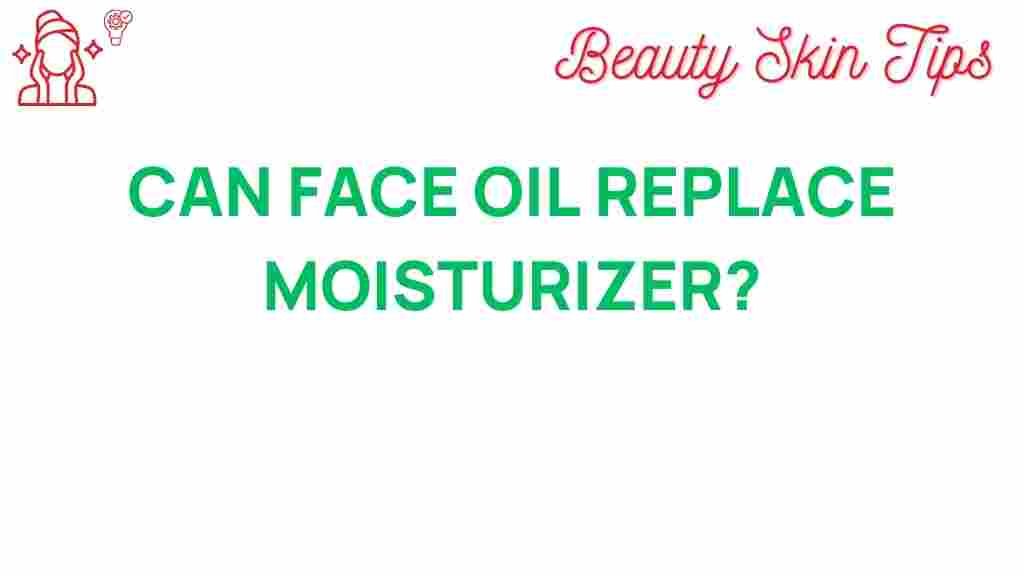Can Face Oil Truly Replace Moisturizer? The Surprising Answer Awaits
When it comes to skincare, the debate over whether face oil can replace moisturizer is a hot topic among beauty enthusiasts and experts alike. With the rise of natural beauty products and the emphasis on hydrating skin, many are left wondering if they should swap out their traditional moisturizer for face oil. In this article, we’ll dive deep into the world of face oil and moisturizer to find out if face oil can truly take the place of moisturizer in your skincare routine.
Understanding Face Oil
Face oil is a concentrated skincare product that is primarily made from plant-based oils, essential oils, and sometimes, synthetic ingredients. Unlike moisturizers, which often contain water as a primary ingredient, face oils are designed to penetrate the skin more deeply, providing nourishment and hydration.
- Benefits of Face Oil:
- Moisturizes the skin
- Provides antioxidants
- Enhances skin barrier function
- Helps with skin conditions like eczema and acne
The Role of Moisturizer in Skincare
Moisturizers serve the primary purpose of hydrating the skin and preventing water loss. They come in various forms, including creams, lotions, gels, and ointments. Moisturizers typically contain a combination of water, oils, humectants, emollients, and occlusives.
- Key Ingredients in Moisturizers:
- Water: Hydrates the skin
- Glycerin: A powerful humectant that draws moisture
- Shea Butter: An emollient that softens the skin
- Ceramides: Help restore skin barrier
How Face Oil and Moisturizer Work Together
Before we jump into whether face oil can replace moisturizer, it’s essential to understand how these two products can work together. Combining face oil with moisturizer can enhance the overall hydration of your skin. Here’s how:
- Layering: Applying face oil after your moisturizer can lock in moisture, preventing water loss.
- Ingredient Synergy: Some face oils contain ingredients that complement those found in moisturizers, enhancing their effectiveness.
Step-by-Step Guide: Using Face Oil in Your Routine
If you’re considering incorporating face oil into your skincare routine, here’s a simple step-by-step guide:
- Cleanse: Begin with a gentle cleanser to remove makeup and impurities.
- Tone: Apply toner to balance the skin’s pH and prepare it for hydration.
- Apply Face Oil: Use a few drops of face oil and gently press it into your skin. Focus on areas that feel particularly dry.
- Moisturize: For added hydration, follow up with a lightweight moisturizer. This step is especially important for those with dry or dehydrated skin.
- Sunscreen: If you’re going out during the day, don’t forget to apply sunscreen as the last step.
Can Face Oil Replace Moisturizer?
Now, the million-dollar question: Can face oil truly replace moisturizer? The answer is not straightforward and depends on various factors:
- Skin Type: If you have oily or acne-prone skin, you may find that face oil works well for your needs. However, those with dry skin might benefit more from a traditional moisturizer.
- Climate: In humid climates, face oil may suffice, while in arid conditions, a moisturizer might be necessary to combat moisture loss.
- Season: During colder months, your skin may crave more hydration, necessitating a moisturizer even if you use face oil.
Troubleshooting: When Face Oil Isn’t Enough
While face oil offers numerous benefits, there may be instances where it falls short. Here are some troubleshooting tips:
- Excess Oiliness: If you find your skin feeling too oily, consider using a lighter oil or reducing the amount you apply.
- Dry Patches: If dry patches persist, layer a moisturizer on top of the oil to provide additional hydration.
- Breakouts: If you experience breakouts after using face oil, consider switching to non-comedogenic oils, such as jojoba or argan oil.
Choosing the Right Face Oil
Not all face oils are created equal. Here are some tips for choosing the right one:
- Skin Type: Choose oils that cater to your specific skin type. For example, rosehip oil is great for dry skin, while tea tree oil may benefit those with oily skin.
- Ingredient Quality: Look for cold-pressed, organic oils without synthetic additives.
- Patch Test: Always do a patch test to ensure you won’t have an adverse reaction.
Conclusion
In conclusion, whether face oil can replace moisturizer depends on individual skin types, needs, and environmental factors. For some, face oil may be all they need for hydration, while others may find that a combination of both products yields the best results. The key is to listen to your skin and adjust your routine accordingly.
If you’re looking for more information on skincare routines, check out our comprehensive guide. For the latest in skincare research, visit this informative resource.
Ultimately, face oil is a fantastic addition to any skincare regime, but it may not completely replace moisturizer for everyone. Explore, experiment, and find what works best for your unique skin!
This article is in the category Skincare and created by BeautySkinTips Team
